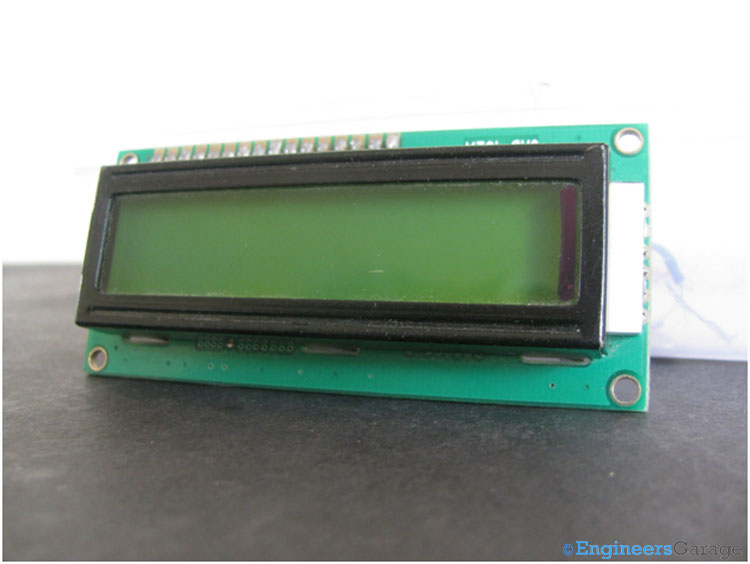LCD, an acronym for Liquid Crystal Display revolutionized the modern display technology with its compactness and versatility. Today it is seen embedded in various electronic gadgets and devices like T.V., Computers, Laptops, Watches, etc. A Liquid crystal coating is the heart of the display which is sandwiched between two polarized glasses.
LCD’s are available in various shapes and sizes depending on the configurations. A 16×2 LCD shown in the image below can display 32 characters with 16 characters in each row. It is capable to display any character with ASCII values ranging from 0 to 255.

Fig. 1: Image of 16X2 LCD

Fig. 2: PCB and Circuit Arrangement of LCD
In the backside of LCD, a PCB is attached which contains the required circuitry to process the signals. The key component of the circuitry is a controller and memory in the form of COB IC.
Display Glass

Fig. 3: LCD display Glass

Fig. 4: Back View of LCD Display Glass
The display glass with the liquid crystal layer in between, on separating with the rest of the LCD structure is shown in the image above.
Glass Assembly

Fig. 5: A View of LCD Glass Assembly
The above image shows a clear picture of the glass assembly with liquid crystal layer after removing the mechanical structure which is used to hold the glass. The lines on the corners of the glass are the electrodes used supply the necessary electric potential to the liquid crystals. Different layers of the LCD glass are shown in the following figure.

Fig. 6: Diagram Showing Different Layers of LCD Glass
A liquid crystal cell is sandwiched between alignment layers, electrodes, glass plates and polarizers. The electrodes are used to apply voltage over the crystals.
Polarizer & Liquid Crystal

Fig. 7: Polarizer Films Glued to LCD Glass
There are two thin films of polarizer glued on both sides of the glass. The purpose of the polarizer is to allow the right amount of backlight to pass through it in order to have a proper display.

Fig. 8: Disintegrated LCD Glass Indicating Arrangement of Glass Layers and Liquid Crystals
On breaking the display glass, two different layers of the glass are visible as shown in the above image. Amid of them there is a very thin layer of liquid crystals sandwiched between two electrodes.
Control Circuitry & Backlight

Fig. 9: Control Circuit and Backlight of LED
This is part of the LCD module which comprises the control circuitry and a backlight LED. The control circuit sends the electrical signals to the electrodes inside the display unit through the pins indicated.

Fig. 10: Embedded LED for Backlight
The above image shows the structure responsible for providing the necessary backlight. It contains an embedded LED.
Diffuser & PCB

Fig. 11: Diffuser Plate
In this LCD an LED embedded in a diffuser plate is used as a light source. The purpose of the diffuser plate is to uniformly distribute the light over the display area. Two white colored sheets are placed at the top and bottom of the diffuser plate. These sheets reflect the LED light back into the diffuser plate thereby preventing it to escape to the external environment.

Fig.12: PCB of LCD
Removing the backlight will not affect the functionalities of the LCD and it will continue to display the text but with lower visibility.
Connectors
Fig. 13: Image Showing Silicon Connectors of LCD
Two LCD silicon connectors are shown in the above image. The black strip on the connector bar is a conductor material that connects the electrodes on the LCD glass with the control circuit. It is more clearly visible in the below image.

Fig. 14: Image Showing Black Strip of Bar
Different segments on the bar work alike the different wires that are insulated with each other.
Working:
The liquid crystals used in the LCD are Twisted Nemantic (TN), a type of liquid crystals that are twisted at 90o with the surface. In this state, crystals allow the light to pass through the polarizer but on applying a voltage, they get untwisted and block the light to passing through the polarizer.
The LCD controller in the form of COB IC sends the electric signals to the electrodes which are sandwiched in between the glasses. Electrodes apply the voltage to the corresponding crystals as per the signals received from the ICs. These crystals are then untwisted and blocks the light (from LED strip) making those area darker on the glass. By applying voltage to specific crystals, a desired shape is formed on the LCD.
Filed Under: Insight


Questions related to this article?
👉Ask and discuss on Electro-Tech-Online.com and EDAboard.com forums.
Tell Us What You Think!!
You must be logged in to post a comment.